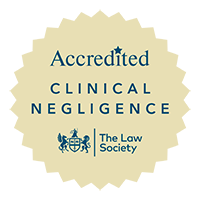Top ranked cerebral palsy claims lawyers
A review by the NHS Race and Health Observatory has found that babies of Black, Asian and ethnic minority ethnicity have a higher risk of delayed diagnosis of serious neonatal conditions which are diagnosed by assessment of skin colour.
The ‘Review of neonatal assessment and practice in Black, Asian, and minority ethnic newborns: Exploring the Apgar score, the detection of cyanosis and jaundice’, found that current guidance, health professional training and standard practices used to assess the health of newborn babies are often unsuitable for Black, Asian and minority ethnic babies.
Recent reports have raised awareness of the unacceptable inequalities in UK maternity healthcare experienced by mothers and babies of non-White ethnicity, which leave Black and Asian women and their babies at higher risk of stillbirth, and maternal and neonatal death.
This review explored growing concerns that many standard neonatal healthcare assessments rely on an initial, visual assessment of the baby’s skin colour, with ‘normal’ skin colour based on guidelines that were written to describe White babies. It focussed on the guidance, policies and assessment of neonatal skin colour used to assess a newborn baby’s health via the Apgar score, and to check for signs of cyanosis and neonatal jaundice. Its findings raise serious concerns that most of the current guidelines and training resources for neonatal testing do not consider differences in skin pigmentation and, therefore, fail to provide reliable and safe neonatal care for darker skinned babies.
Is the APGAR score safe to assess darker-skinned babies?
The Apgar score was developed in the 1950s and is still used by maternity and neonatal healthcare staff as a quick and convenient standardised way of reporting a baby’s condition at birth. The test scores the baby’s appearance (colour), pulse (heart rate), grimace (reflex), activity (tone) and respiratory effort (breathing), giving a score of 0 to 2 for each area at 1 minute, 5 minutes and 10 minutes after birth.
In relation to colour or appearance, various guidance and training resources suggest using the terms “pink”, “pink all over” or “all pink” to describe a well-perfused baby with a score of 2. “Pale or blue” should be used for a score of 1, and “white” for a score of 0. The review found that the lack of guidance and training relation to assessing ‘appearance’ in babies with darker skin tones has resulted in many healthcare professionals developing their own (subjective) ways of assessing whether a baby satisfies the criteria for ‘pink’, ‘white’ or ‘blue’. Most of the healthcare professionals and parents who were interviewed by the review, and previously surveyed midwives, felt that the term “pink” was irrelevant to Black, Asian, and minority ethnic babies. Previous research has also flagged a need to extend the Apgar score assessment to more accurately assess the health of African, Caribbean, and Asian newborn babies.
The continued use of the Apgar score and its colour assessment has also been questioned in previous studies which point out that appearance/colour is the area that is least correlated with cord pH, arterial carbon dioxide (pCO2) and base excess (important indicators of lack of oxygen or hypoxia/HIE in a newborn baby) and that only the heart rate and respiratory effort scores are predictive of neonatal morbidity and mortality. Research has also identified inconsistencies in the Apgar scoring by different types of professionals (such as midwives, neonatologists and obstetricians), hospitals and European countries, and that Black babies are more likely to receive lower scores.
Jaundice
The review specifically examined the use of skin colour assessment in the diagnosis of neonatal jaundice or hyperbilirubinaemia. Recognition, monitoring and timely treatment of neonatal jaundice are vital to prevent the development of kernicterus, a dangerous condition which causes severe, permanent disability from injury to the brain. Kernicterus is preventable with correct neonatal care. HSIB recently reported that medical negligence claims arising from kernicterus brain injury caused by missed or delayed diagnosis and treatment of jaundice have cost the NHS around £150.5 million over the last ten years.
Jaundice is characterised by a yellow discolouration of the skin and sclera (white of the eye). Initial diagnosis of jaundice usually depends on a visual assessment of a baby’s skin colour, which can be subjective and inaccurate, particularly for babies with Black or dark skin. These difficulties are recognised by NICE guidance which warns that the visual detection of jaundice in darker skin tones is “almost impossible”. This is important because ethnic minority newborn babies naturally have an increased risk of jaundice compared with White babies but are also the most likely to have their jaundice missed in a visual assessment.
Many of the healthcare professionals who were interviewed by the review could not remember ever having been trained in the identification of jaundice in Black, Asian, and minority ethnic newborn babies. Healthcare staff told the review that they found it easier to detect jaundice in Black and minority ethnic babies by assessing the sclera and the gums, but they readily used further testing via transcutaneous bilirubin (TCB) devices or serum bilirubin blood tests if any signs of jaundice were detected. TCB monitoring devices screen for neonatal jaundice without subjecting the baby to repeated blood tests and, despite the additional cost to trusts, can help avoid claims from missed diagnosis. However, concerns have also been raised that TCB devices have been found to over-estimate the bilirubin levels in darker-skinned babies.
The review points out that despite concerns expressed by the NICE guidance and clinicians about the inaccuracy and difficulty of using skin colour to assess jaundice in Black and brown babies, this awareness has not led to updated policies, guidance or healthcare education. This makes it all the more important for maternity and neonatal professionals to listen to parents’ concerns, as failure to act on parents’ concerns about their baby’s jaundice has led to delays in diagnosis and treatment, severe injury and compensation claims. The report also referred to cases where parents did not recognise signs of jaundice in their child and warned that healthcare professionals should not solely rely on parental awareness to diagnose jaundice.
Cyanosis
Cyanosis (lack of oxygen/hypoxia or poor blood circulation) is another dangerous condition that relies on visual assessment of colour for diagnosis. The review referred to the NICE intrapartum (childbirth) guidelines which say that when a baby is born at higher risk (such as from meconium or prolonged rupture of membranes the maternity team should check for cyanosis and confirm with pulse oximetry if available. A pulse oximeter is a non-invasive device which clips onto a finger and measures the oxygen level in the blood.
Neonatal hypoxia can be characterised by ‘blue’ or ‘pale’ discolouration of the baby’s skin or lips. Diagnosis of cyanosis by visual assessment alone is known to be difficult, especially in babies with darker skin, and varies in reliability between clinicians. Guidance and training resources refer to “mottled”, “blue”, “pale” or “ashen” as potential signs that a baby is suffering respiratory distress. One online resource suggests that “any change from the established centrally pink colour in a newborn is always abnormal” and that central colour change was most “reliably noted in the lips, gums and tongue” and can be “paleness or dusky blue”. Guidelines and training resources point out that oxygenation should not be determined by skin colour alone and recommend that any baby with a “dusky appearance” should have their pulse oximetry checked. The Resuscitation Council advises that floppiness, poor breathing and slow heart rate with “pale” colour suggests significant hypoxia, but warns against relying on visual observation alone.
None of the guidelines specifically advise on how cyanosis or hypoxia should be assessed in babies with different skin pigmentation or ethnicity. Healthcare professionals who were interviewed during the review identified the mouth mucosa and lips as the best place to assess for cyanosis in babies of all ethnicities when pulse oximetry was not available.
Pulse oximetry devices reduce the reliance on visual inspection of skin colour to diagnose or screen for cyanosis but have been calibrated for use on White skin. Recent research has identified that, although more accurate than visual inspection, pulse oximetry may not be as accurate in detecting low oxygen levels in Black and minority ethnic preterm babies. The COVID-19 pandemic also highlighted, amongst other disparities, that pulse oximetry in dark skinned patients was more likely to give inaccurate readings.
Impact of ethnicity on healthcare
The review focussed on neonatal care but also identified more general themes which confirmed findings of other reports about the impact of ethnicity on healthcare. These included barriers and assumptions affecting communication, stereotyping, discrimination, racism and lack of cultural competence resulting in traumatic maternity experiences and inadequate care. The maternity and neonatal experience of Black, Asian and ethnic minority mothers and babies was affected by systemic and organisational factors, such as staff workload pressures and lack of training, which caused staff to rely on their biases and assumptions. Social and economic factors, such as deprivation, poor housing, nutrition, isolation and mental health issues also affect people from ethnic minorities disproportionately and have an impact on their maternity care.
NHS Race and Health Observatory review calls for change
The NHS Race and Health Observatory’s review highlights the need for more cultural competence to provide all mothers and babies with personalised, safe care. It recommends extensive research, review and updating of policy, guidance, training and practice to ensure that UK maternity and neonatal healthcare services provide all mothers and babies, regardless of ethnicity or background, with safe and equitable care.
If you have suffered severe injury as a result of medical negligence or have been contacted by HSIB/HSSIB/MNSI/CQC or NHS Resolution, you can talk to a solicitor, free and confidentially, for advice about how to respond or make a claim by contacting us.

Written by Susan Brown
Medical Negligence Partner
They have a great deal of knowledge and expertise, and client care seems to be their top priority.
Chambers Guide to the Legal Profession
Contact our expert Cerebral Palsy solicitors today for support with your claim




